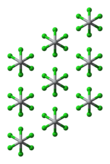
| |||
| |||
| Names | |||
|---|---|---|---|
| Other names
titanium trichloride
titanous chloride | |||
| Identifiers | |||
3D model (JSmol)
|
|||
| ChemSpider | |||
| ECHA InfoCard | 100.028.845 | ||
| EC Number |
| ||
PubChem CID
|
|||
| RTECS number |
| ||
| UNII | |||
CompTox Dashboard (EPA)
|
|||
| |||
| |||
| Properties | |||
| TiCl3 | |||
| Molar mass | 154.225 g/mol | ||
| Appearance | red-violet crystals hygroscopic | ||
| Density | 2.64 g/cm3[1] | ||
| Melting point | 440 °C (824 °F; 713 K) (decomposes)[1] | ||
| very soluble | |||
| Solubility | soluble in acetone, acetonitrile, certain amines; insoluble in ether and hydrocarbons | ||
| +1110.0×10−6 cm3/mol | |||
Refractive index (nD)
|
1.4856 | ||
| Hazards | |||
| Occupational safety and health (OHS/OSH): | |||
Main hazards
|
Corrosive | ||
| Safety data sheet (SDS) | External MSDS | ||
| Related compounds | |||
Other anions
|
Titanium(III) fluoride Titanium(III) bromide Titanium(III) iodide | ||
Other cations
|
Scandium(III) chloride Chromium(III) chloride Vanadium(III) chloride | ||
Related compounds
|
Titanium(IV) chloride Titanium(II) chloride | ||
Except where otherwise noted, data are given for materials in their standard state (at 25 °C [77 °F], 100 kPa).
| |||
Titanium(III) chloride is the inorganic compound with the formula TiCl3. At least four distinct species have this formula; additionally hydrated derivatives are known. TiCl3 is one of the most common halides of titanium and is an important catalyst for the manufacture of polyolefins.

